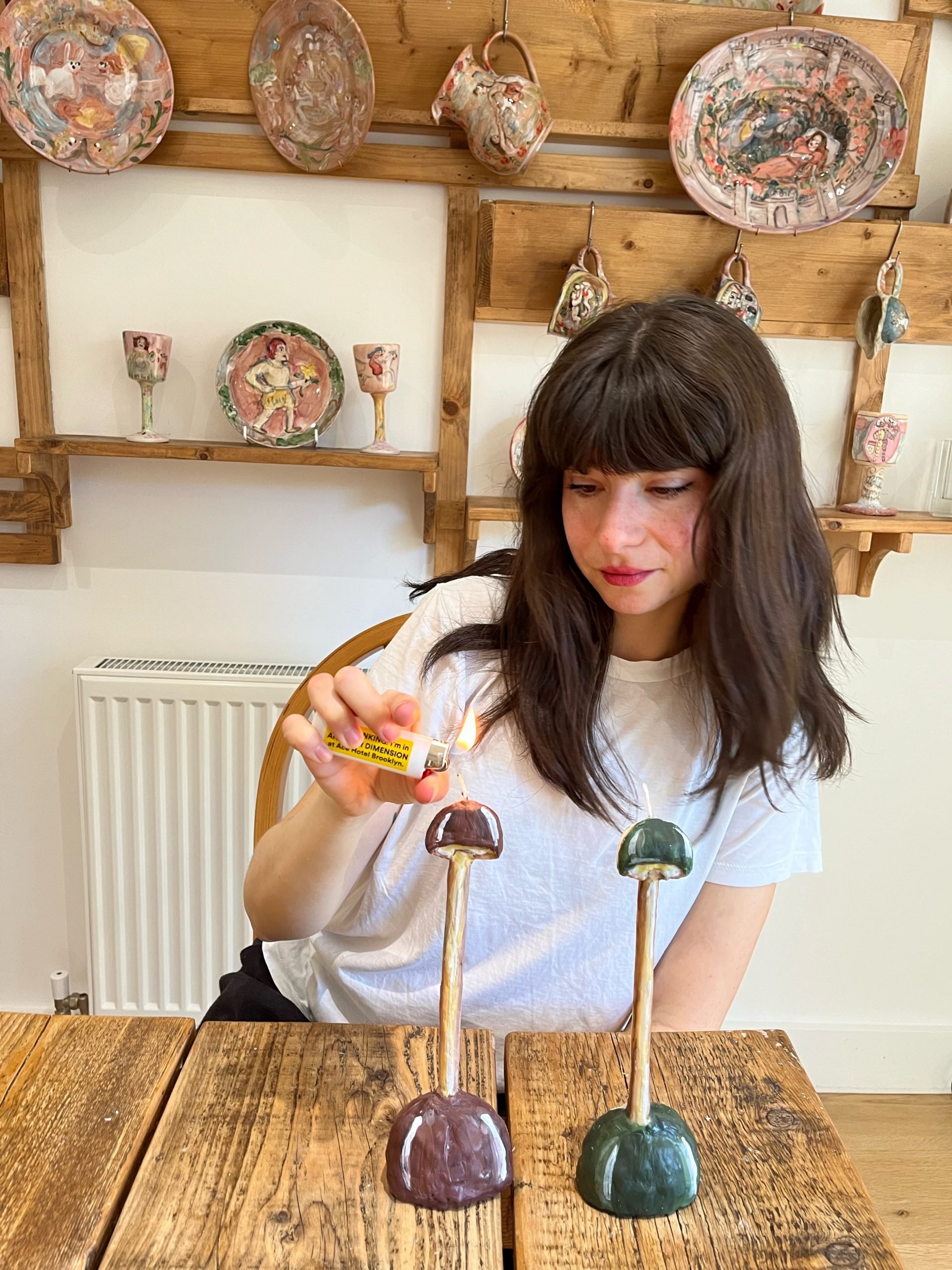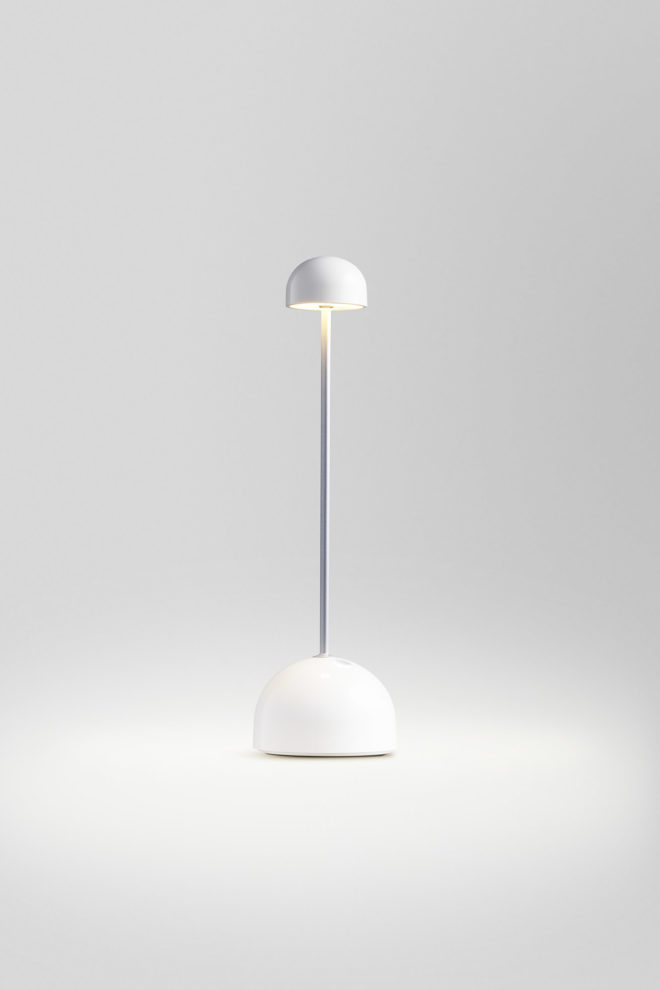Marset Featuring
Janie Korn
Sips
Melting and moulding light
Janie Korn is an American-born, London-based visual artist and wax sculptor. The artist models and creates candles, bringing them to life and giving them a story to tell.
She sees the process of creating candles as a ritual in itself.

Hello Janie, it's a pleasure to work together with you. Thanks for taking the time to sit down with us and share a bit more of your creativity.
Your creations range from everyday objects to custom orders of animals and people, from nostalgic projects to movie-inspired candles. When did you realise this was a path you wanted to pursue?
JKBefore coming to candles, I’d been working with these very rigid resin sculptures with little self portraits embedded inside. Resin is quite toxic and non-biodegradable on top of that, so over time I began to feel the massive impact my art was having on my own health and the planet's, too. That was the jumping-off point that shifted me to create in a more ephemeral space. First it was edible sculpture - but I couldn't stop eating my materials! And then eventually wax. I love that this material turns the subject matter into a non-permanent concept; into something fleeting.
The malleability and possibilities of wax contrast with the impermanence of a burning candle. What’s your favourite part of the candle-making process?
JKI love the physicality of it! I don't use thermometers anymore and the temperature settings on my equipment have long since worn off, so I rely on my fingers to test the wax. Rubbing drops between my fingertips, I can gauge the viscosity and the oil composition. I feel like a witch hunched over my cauldron, performing my craft.
Candles can form part of many routine rituals; from creating an ambience to having a moment to yourself. Do you have a ritual of your own before starting a new candle?
JKMy ritual takes place while I’m actually making the candle, rather than before it. I don't tend to sketch out my ideas or plan much in advance. But as I’m in the throes of creation, there's a moment where I'm fully plugged in with the process and it feels almost as if I’m following the signs of the wax. It's an incredibly spontaneous feeling and often I end up with a totally different creation than I expected to make that day.
Do you burn your own candles?
JKHahaha, sometimes! Very occasionally, since they take so long to make. But for special occasions, to mark something meaningful, yes. I think there’s something very powerful about the spiritual release they give.
In a line of work as well-established as yours, is there still room for experimenting? Is it important?
JKAbsolutely. Throughout my career I've always explored different mediums and brought everything back to my central focus. For an exhibition this November in New York, I'm uniting traditional ceramic handbuilding with my candle-sculpting to create an alchemist's altar, covered with magical candles and potion bottles. In the future I have plans to incorporate glass.

Your candles are dubbed “magic candles”. When working with dimensional objects, light and shadow can contribute a lot to building the magic. Is that something you think of when creating candles that will be showcased?
JKSomewhat, but in a looser sense. When making the piece I try to imbue it with emotion and significance. But I also believe that, when it leaves my hands, the magical qualities are transferred to the owner and they are responsible for building their own magic relationship with it. If they want to illuminate it or melt it, it's theirs now.
There's poetry in creating a lamp-shaped candle. Was Sips challenging to carve?
JKThe Sips was a challenging one! That perfectly slender support is a key element and if I wasn't able to get that right, the whole piece wouldn't have come together. Wax is a very finicky and brittle material. At first I sculpted that support as I would normally- by tempering and layering wax into a column. But it just wasn't strong enough to hold everything together. In the middle of the night I had a lightbulb moment (pun intended); rather than hand sculpt that support, I would start with a harder wax block and carve it down. As a contrast, the lightweight wax used on the base and bulb balanced effortlessly.
Sips is a portable lamp, which gives the freedom to move it around as you wish. Where will yours go?
JKI moved to London a year ago and, for the first time in my adult life, I have my own garden, and I inherited it with already-planted beds of mint and rosemary, and a wall of fragrant jasmine climbing up the fence. The Sips will wander out back with me to sit on the table, illuminating al fresco dinners and desserts.
At Marset, one part of creating good designs is to make a product that not only casts light beautifully but also endures and surprises. What are the main aspects you take in consideration when creating your candles?
JKEngineering the candle is the first thing I think about when approaching a design. Wax has its restrictions and can't articulate extremely fine details. But the advantage of this is that it pushes me to work with more extreme shapes, more negative space and strong internal structures. When pieces break, superglue won't work and it's hard for customers to make repairs on their own, so I’m equally concerned with structural integrity as I am with the aesthetic result.
Lastly, could you share some habits that help boost your creativity?
JKWhenever I'm feeling dull, I take a continuing ed class in an art form entirely unrelated to what I'm working in. Being a beginner is so humbling in the best way possible. I find that, when you don't yet have the expert skills in a given field, the brain works in incredible ways to come up with easy workarounds. In that space, really amazing ingenuity flourishes. I've always been able to bring these lessons back to my main practice in interesting ways.


